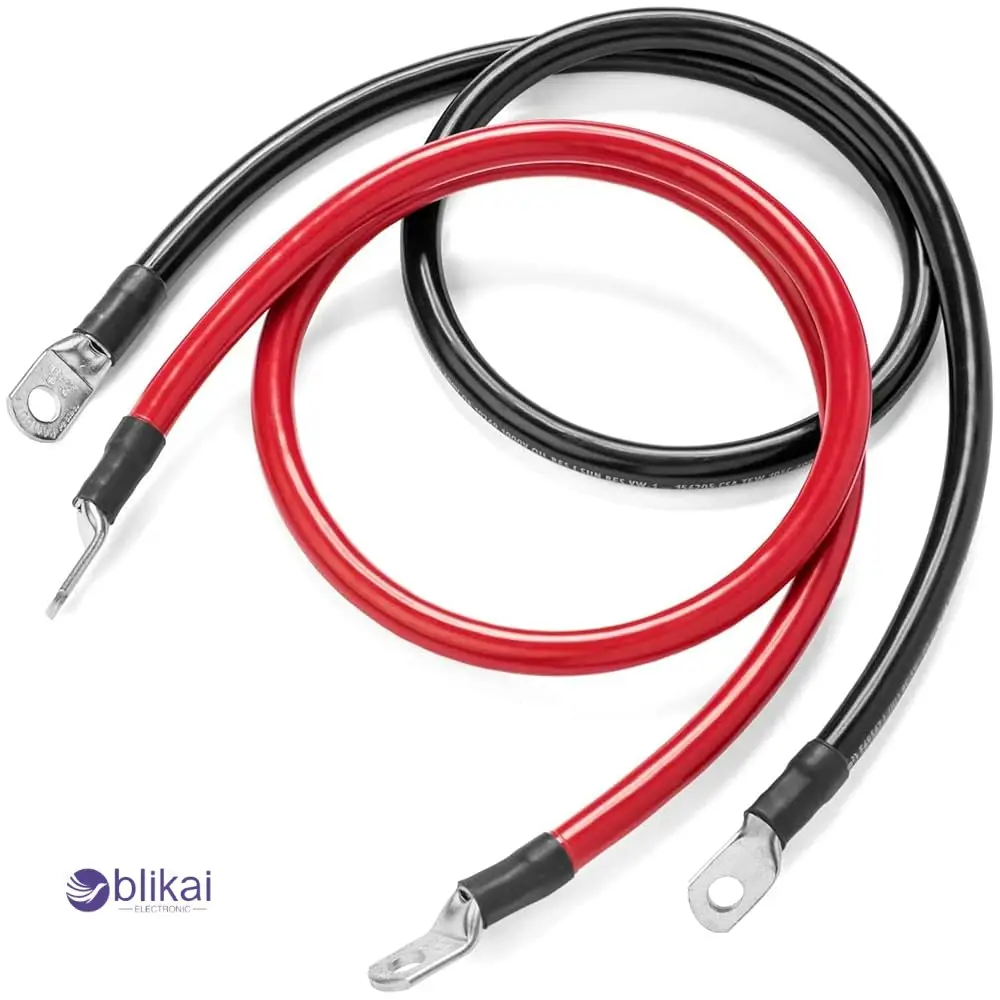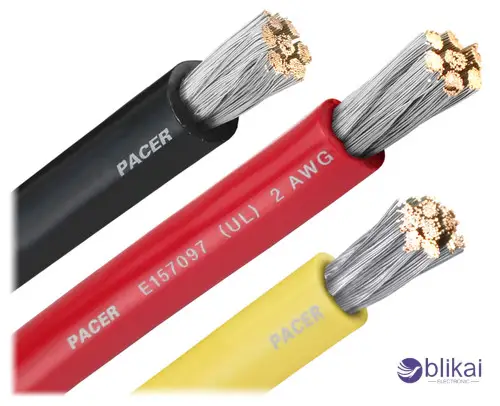2 Gauge Battery Cable: Applications, Features & Comparisons
What is a 2 Gauge Battery Cable?
A 2 gauge battery cable is an electric wire of a standard thickness and size of current-carrying capacity based on the American Wire Gauge (AWG) scale. Practically speaking, a 2 gauge cable is around 0.2576 inches (6.544 mm) in diameter and is rated to easily support high current loads without overheating or high voltage drop. This thickness enables the cable to resist the conductive properties over extended distances, and this is necessary when providing constant power to electrical hardware that requires immense power. Its strong construction still has an applicability of stranded copper wire to be flexible and an insulating layer that is durable so as to withstand abrasion, heat and corrosion.
The 2 gauge battery cables are versatile and hence fit most appropriately in most applications. They are frequently found in automotive applications to connect the battery to the starter motor, alternator and other high-draw components. In marine, 2 gauge cables are the preferred choice when it comes to powering boat motors and on-board electronics because they can resist very adverse weather conditions and they maintain a steady power supply. They are also common in RVs and solar power systems to interconnect batteries, inverters and other devices. Their strength, flexibility, and capacity are some aspects that make 2 gauge cables a sure option in any mid-level electrical power application.

Key Features of 2 Gauge Battery Cables
High Current-Carrying Capacity
One of the most important features of a 2 gauge battery cable is its ability to carry high currents safely and efficiently. Designed with a relatively large wire diameter, a 2 gauge cable can handle the electrical demands of medium to heavy power systems without excessive voltage drop. This makes sure that starter motors, alternators and other high-draw parts of a vehicle, boat or RVs can get uninterrupted power when required. The capacity of the cable also limits the chances of overheating, which is a major problem when using small cables. In more demanding applications like marine engines or off-road, a cable that will consistently deliver high current is necessary both in performance and safety.
Durable Insulation Materials
Another major quality feature of 2 gauge battery cables is durability. Most of these cables are coated using material such as PVC, Teflon or marine material resistant to heat, abrasion and corrosion. This layer protects the copper wire in the event that the environment damages the wire, such as moisture in a boat or friction and vibration in a car. Anti-rust materials will be used to make sure that no rust will be present on the terminals to damage the electrical performance in the long run. The insulation is heat-resistant, so that when heavy loads are used, the cable does not melt or deform structurally. This performance can be directly related to a lifetime and decrease the maintenance requirements of battery systems.
Flexibility for Easy Installation
Although thick, a high-quality 2 gauge battery cable is flexible enough to install effectively in tight or structurally complex locations. Stranded copper construction enables the cable to be bent and twisted around obstacles without breaking and becoming conductive. This flexibility is desired particularly in cars and boats, where there may not be a lot of space surrounding engines, battery compartments, and electrical panels. The flexibility of cables leads to their ease of installation, fewer strains on connectors, and kinking and internal damage during routing can also be avoided. A 2 gauge cable has the capability of offering strength and flexibility to make it user-friendly and reliable, which is why it is a common item among amateur DIYers and installers on the job.
What is the Application Range of a 2 Gauge Battery Cable?
Automotive Applications
Using 2 gauge battery cables is common in automotive electrical systems that need moderate to high current. They are perfect in linking car and truck batteries to starters, alternators and high-draw accessories like audio systems, lighting or auxiliary electronics. With low resistance and a very low thickness, they have minimal voltage drop, which guarantees reliable engine starts and consistent operation of all electrical components. In vehicles that have numerous electrical accessories or off-road additions, 2 gauge cable offers the best solution of capacity, flexibility, and durability, as it delivers a consistent power supply without compromising the system.
Marine and Boat Applications
Normally 2 gauge battery cables are used in powering marine engines, navigation, lights and other on-board electronics. Marine-grade 2 gauge cables are immune to corrosion, moisture, and vibration, hence they can fit small to medium boats. They have steady voltage even during arduous conditions and have engines and electronics that work efficiently, even when several devices may be connected at a time. High current-carrying capacity and the environment-resistance of 2-gauge cables ensure that these cables remain a safe and consistent power supply option to boat owners who require a reliable supply of power in severe marine conditions.
RVs, Solar, and Backup Power Systems
Beyond vehicles and boats, 2 gauge battery cables are also ideal for RV electrical systems, solar power setups, and backup battery configurations. They are used in RVs to provide power to lights, appliances and electronics, connecting their batteries to inverters, converters and distribution panels. They are used in solar systems to transport batteries to charge controllers and inverters to sustain the flow of energy. Likewise, in backup power systems, 2 gauge cables are used to ensure that stored energy is provided safely and reliably during outages. They can be versatile to deal with moderate and high-current applications in a variety of environments with efficiency and safety.

Differences Between 2 Gauge, 2/0 Gauge, and 4 Gauge Battery Cables
Wire Thickness, Diameter, and Current Capacity
The physical diameter, cross-sectional area and the capacity of 2 gauge, 2/0 gauge and 4 gauge battery cables to carry current represent the most basic of the dissimilarities. The 2/0 gauge wire has a diameter of approximately 0.3648 inches (9.27 mm) and a cross-sectional area of approximately 67.4 mm²; thus, it can conveniently handle a constant current of 150-200 amps over short to medium distances with only a moderate voltage drop. By comparison, 2 gauge size wire is about 0.2576 inches (6.54 mm) across the grain, and measures 33.6 mm² (cross-sectional area) with an approximate current carrying capacity of 95-130 amps. Meanwhile, 4 gauge wire, diameter of 0.2043 inches (5.19 mm) and area of 21.2 mm² is restricted to 70-85 amps. These guidelines show that 2/0 is most suited to heavy industry or marine, 2 gauge is mid-range automotive or RV, and 4 gauge is only used with the lighter load or in shorter battery runs.
Electrical Resistance and Voltage Drop Considerations
The smaller the conductor cross-sectional area, the lower the resistance: 2/0 gauge is normally about 0.000078 ohms/ft, 2 gauge is about 0.000156 ohms/ft, and 4 gauge is about 0.000248 ohms/ft. Reduced resistance is important as it reduces the voltage drop over long circuits, which is essential to high-demand systems, including the start of large engines or for powering sensitive electronics. An implementation of a 4 gauge wire on a circuit with 2 gauge requirements may cause voltage drops of over 0.51 volt over long distances, which may decrease the efficiency of a starter or lead to underperformance of electronics, whereas 2/0 wire can carry high loads with negligible voltage drop.
Applications, Safety, and Environmental Factors
High-power 2/0 gauge is typically employed in high-power applications, such as large marine engines, industrial battery banks, industrial heavy-duty trucks, and winches with continuous current demands of over 150 amperes, and medium-demand 2 gauge is suitable, as is 4 gauge in lower-demand applications, auxiliary circuits, or other short-circuit connections in the range of 90-130 amperes. The benefits of the proper gauge in terms of safety are the prevention of overheating, the risk of insulation degradation, and safety against possible fire.
Conclusion
Medium-to-high current electrical systems require 2 gauge battery cables to deliver dependable power to starters, alternators, electronics, and inverters to cars, trucks, boats, RVs, and solar systems. Their greater diameter and low resistance keep them to a minimum voltage drop, which maintains their consistent performance, even at moderate ranges. Enduring insulation is resistant to heat, abrasion, corrosion and moisture as well, and stranded copper construction is flexible to install in a tight space. In comparison with thinner wires, 2 has a higher current-carrying capacity under safe conditions, and it is also usable in mid-range use, as opposed to 2/0. The selection of appropriate 2 gauge cable boosts efficiency, reliability, and safety, and thus it is a reliable option in any system that demands consistently good and unwavering power.
Some images are sourced online. Please contact us for removal if any copyright concerns arise.
Monitor Cables: Types, Applications & Advantages
RJ45 Cables: A Guide to Ethernet Connectivity
Network Cable Connectors: Types, and Applications
D-Sub Cables: Types, Applications & Advantages
Modular Cables: Types, Advantages & Applications
What is Firewire Cables? All Explained
The Power of RG11 Coaxial Cable: Advantages and Applications
Varieties of Monitor Cables: A Beginner's Guide
Varieties of Electrical Wires and Cables
What is RJ11 Connector & How it Work?










